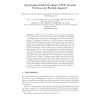Free Online Productivity Tools
i2Speak
i2Symbol
i2OCR
iTex2Img
iWeb2Print
iWeb2Shot
i2Type
iPdf2Split
iPdf2Merge
i2Bopomofo
i2Arabic
i2Style
i2Image
i2PDF
iLatex2Rtf
Sci2ools
PRIB
2009
Springer
2009
Springer
Knowledge-Guided Docking of WW Domain Proteins and Flexible Ligands
Studies of interactions between protein domains and ligands are important in many aspects such as cellular signaling. We present a knowledge-guided approach for docking protein domains and flexible ligands. The approach is applied to the WW domain, a small protein module mediating signaling complexes which have been implicated in diseases such as muscular dystrophy and Liddle’s syndrome. The first stage of the approach employs a substring search for two binding grooves of WW domains and possible binding motifs of peptide ligands based on known features. The second stage aligns the ligand’s peptide backbone to the two binding grooves using a quasi-Newton constrained optimization algorithm. The backbone-aligned ligands produced serve as good starting points to the third stage which uses any flexible docking algorithm to perform the docking. The experimental results demonstrate that the backbone alignment method in the second stage performs better than conventional rigid superposit...
| Added | 27 May 2010 |
| Updated | 27 May 2010 |
| Type | Conference |
| Year | 2009 |
| Where | PRIB |
| Authors | Haiyun Lu, Hao Li, Shamima Banu Bte Sm Rashid, Wee Kheng Leow, Yih-Cherng Liou |
Comments (0)

